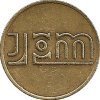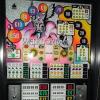This is an interesting project. There is absolutely no information on this tech so I've been working pretty much in the dark. I've already posted a ROM dump and some diagrams.
So far I've come across two varieties of these boards.The differences being in the master oscillator section. This tech doesn't use a crystal? The master oscillator is generated by an MC8602(9602) multivibrator and buffered with a 74LS04. The timing is done with high stability resistors and silver mica caps. The two types of boards both have the holes drilled for the chips and components but one has them fitted on the main board whereas the other has them on a daughter board bolted next to the regulator board on the chassis.
The track layout of both boards is slightly different in the oscillator area. No other differences have been noted as yet.
One common fault appears to be the track fusing between F1, R130 and D14. This carries the 12v line to various circuits as well as the feed to the regulator board. There is also a fusible link (FL3) between D12 and D13 which sometimes blows or gets broken as it's very fine wire.
The second picture is a previous repair to a track burn out.
One gotcha on this tech is the user micro switches. They are set to break on push which is the reverse to most techs I think. The RESET circuit is basically the same as MPU3. All boards should have their LM723 regulator chip changed as all the ones I've seen so far were way out of limits, some over 5.2V!
The main smoothing cap needs changing, it's a 2200uF 25v same as MPU3. There is also a cap on the electro mech interface board which will also need swapping out (100uF 63v). Some types of this tech use a slingshot reel mech but I haven't seen one of those as yet.
The one really good thing about this tech is there's no battery and consequently no corrosion. The RAM is just 128 Bytes and is static so I haven't a clue how it works out percentage payouts? One bad thing is there doesn't appear to be any test modes, at least I haven't found any method of instigating any? Free play mode with the door open appears to be the only one! Unless anyone knows different. There's no mutilplex circuitry for switches or lamps so it's pretty simple to chase faults.
The triacs are different though as there is an enable circuit that grounds all the triac drivers which can be checked via test pins TCA and TCB. However this is pulse driven from a multivibrator oscillator to prevent the triacs continuously locking on. TCA and TCB are situated just under the ROM cart socket.
The sound is generated directly from the PIA (6820) and uses one of the lamp driver transistors. I didn't believe it either until I traced it out! Once you know the RESET is OK, the easiest method for seeing if the MPU is booting is to operate one of the coin input switches, before powering up. You should be greeted with an alarm and in which case you know it's running.
Now don't laugh but here's the beginnings of the Heath Robinson test rig.
Almost finished.
I'll try and do a vid of the test rig in action although with plunging temperatures in my garage there might be a lot of camera shake.




